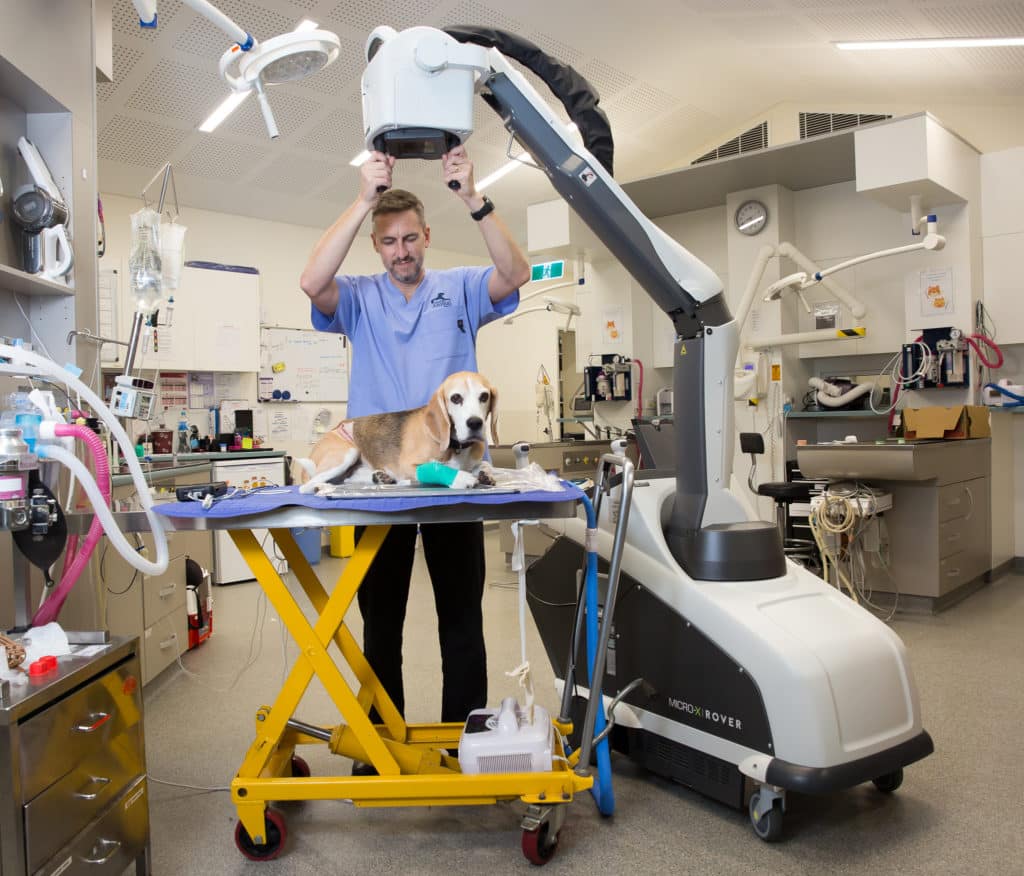Adelaide invention revolutionises veterinary x-rays
Your best friend can’t tell you where it hurts but now, thanks to an invention by Adelaide company Micro-X, vets have a better tool to diagnose your pet’s health problems.
The Micro-X Rover, a mobile x-ray machine was first designed for the Australian military as an ultra-mobile battlefield-ready x-ray machine delivering the full spectrum of imaging solutions.
It has now been adapted to be used by vets, using custom software tailored for small animal exams by Micro-X’s US partner Varex Imaging Corporation.
It is making its debut at Gawler Animal Hospital in Adelaide’s north.
“You can’t just tell a dog, ‘hold your left paw out against the plate!’,” says Gawler Animal Hospital vet Dr Steve Crouch. “But the Rover x-ray machine is easy to position around the patient. “It revolutionises taking radiographs in the veterinary setting.”
Now, thanks to Micro-X’s game-changing carbon nanotube technology, Rover weighs in at just 95kg, including a mobile cart with a moveable arm for easy positioning.
“The cart allows us to move to the animals. That’s great, specially in an emergency when an injured or sick animal doesn’t have to be moved while it is potentially unstable,” says Steve.
It also means that, instead of placing the animal on the x-ray machine’s examination table, the Rover can be used almost anywhere within the veterinary practice.
“Sometimes, an animal feels more secure just lying on the floor instead of being lifted on to a table,” says Steve. “With the Rover it can stay on the ground and have a radiograph taken there!
“It is even possible to take a radiograph horizontally with the animal standing in some situations.” The investment will pay off many times over for Gawler Animal Hospital, which performs a lot of orthopaedic surgeries.
“We have found that taking post-operative x-rays while the patient is still on the operating table has saved so much time but more importantly is so much safer for the patient than moving them back and forth at this important time toward the end of their anaesthetic,” says Steve.
Medical Plus Pty Ltd, a nationwide veterinary sales and distribution company specialising in diagnostic imaging, will distribute the machine in Australia.
Micro-X’s Managing Director, Peter Rowland, said that, along with workflow benefits, Micro-X Rover offers practice owners considerable savings in outlay.
“Rover is a highly competitive offering for animal hospitals seeking to move into high-quality digital radiology,” he said.
“We are proud to have launched the Rover Veterinary mobile x-ray machine in our home market of Adelaide with our first sale and to have appointed a well-regarded Australian distributor.”
Rover’s five-kilogram battery can operate for all day long before recharge and the machine uses modern material science to improve weight and performance, such as x-ray shielding using a tungsten filled polymer instead of lead, and a carbon fibre monocoque chassis.
The patented technology that makes Rover possible is inside the 1.5kg x-ray tube which replaces a conventional x-ray tube weighing more than 20kg.
Traditional x-ray tubes use a hot filament, like an old-fashioned light bulb, to generate the electron stream needed to make x-rays.
But Micro-X’s technology applies voltage to an emitter made from Carbon Nanotubes (CNT) to generate the stream of electrons instead, more like a LED and this is similarly more energy efficient and longer lasting.
Not only are the devices much lighter, they also produce a beam that can be controlled instantly and precisely by simply adjusting the voltage.


